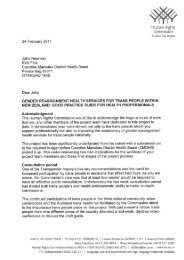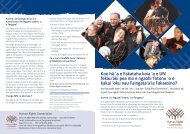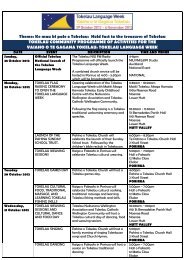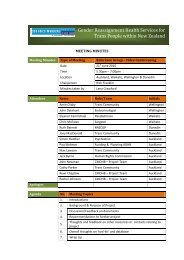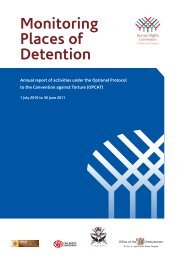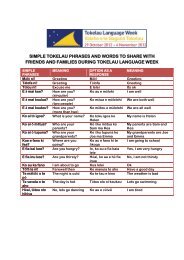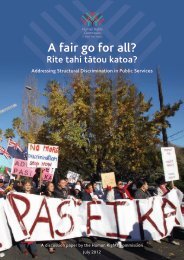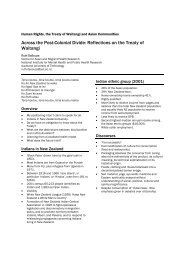Statement of Intent 2013 to 2016 - Human Rights Commission
Statement of Intent 2013 to 2016 - Human Rights Commission
Statement of Intent 2013 to 2016 - Human Rights Commission
You also want an ePaper? Increase the reach of your titles
YUMPU automatically turns print PDFs into web optimized ePapers that Google loves.
46 HUMAN RIGHTS COMMISSION | STATEMENT OF INTENTValue in use is depreciated replacement cost for an assetwhere the future economic benefits or service potential<strong>of</strong> the asset are not primarily dependent on the asset’sability <strong>to</strong> generate net cash inflows and where the entitywould, if deprived <strong>of</strong> the asset, replace its remaining futureeconomic benefits or service potential.If an asset’s carrying amount exceeds its recoverableamount, the asset is impaired and the carrying amountis written down <strong>to</strong> the recoverable amount. The <strong>to</strong>talimpairment loss is recognised in the surplus or deficit. Areversal <strong>of</strong> the impairment loss is also recognised in thesurplus or deficit.Intangible assets that have an indefinite useful life arenot subject <strong>to</strong> amortisation and are tested annually forimpairment. An intangible asset that is not yet availablefor use at the balance sheet date is tested for impairmentannually.Credi<strong>to</strong>rs and other payablesCredi<strong>to</strong>rs and other payables are initially measured at fairvalue and subsequently measured at amortised cost usingthe effective interest method.BorrowingsBorrowings are initially recognised at their fair value.After initial recognition, all borrowings are measured atamortised cost using the effective interest method.Borrowings are classified as current liabilities if theborrowings are expected <strong>to</strong> be settled within 12 months <strong>of</strong>balance date. All other borrowings are classified as a noncurrentliability.Employee entitlementsShort-term employee entitlementsEmployee benefits that are due <strong>to</strong> be settled within 12months after the end <strong>of</strong> the period in which the employeerenders the related service are measured at nominal valuesbased on accrued entitlements at current rates <strong>of</strong> pay. Theseinclude salaries and wages accrued up <strong>to</strong> balance date andannual leave earned but not yet taken at balance date.Long-term employee entitlementsEmployee benefits that are due <strong>to</strong> be settled beyond 12months after the end <strong>of</strong> the period in which the employeerenders the related service, such as long service leave andretirement leave, have been calculated on an actuarialbasis. The calculations are based on:1 likely future entitlements accruing <strong>to</strong> staff, based onyears <strong>of</strong> service, years <strong>to</strong> entitlement, the likelihoodthat staff will reach the point <strong>of</strong> entitlement andcontractual entitlements information2 the present value <strong>of</strong> the estimated future cash flows.Presentation <strong>of</strong> employee entitlementsAccrued salaries and wages, annual leave and vested longservice leave are classified as a current liability. Non-vestedlong service leave and retirement leave expected <strong>to</strong> besettled within 12 months <strong>of</strong> balance date are classifiedas a current liability. All other employee entitlements areclassified as a non-current liability.Superannuation schemesDefined contribution schemesObligations for contributions <strong>to</strong> KiwiSaver, the GovernmentSuperannuation Fund and the Pension National Scheme <strong>of</strong>the National Provident Fund are accounted for as definedcontribution schemes and are recognised as an expense inthe surplus or deficit as incurred.Defined benefit schemesThe <strong>Commission</strong> currently does not make contributions <strong>to</strong>defined benefit schemes.ProvisionsA provision is recognised for future expenditure <strong>of</strong> anuncertain amount or timing when there is a presen<strong>to</strong>bligation (either legal or constructive) as a result <strong>of</strong> a pastevent, it is probable that an outflow <strong>of</strong> future economicbenefits will be required <strong>to</strong> settle the obligation anda reliable estimate can be made <strong>of</strong> the amount <strong>of</strong> theobligation.Provisions are measured at the present value <strong>of</strong> theexpenditure expected <strong>to</strong> be required <strong>to</strong> settle the obligationusing a discount rate that reflects current marketassessments <strong>of</strong> the time value <strong>of</strong> money and the risksspecific <strong>to</strong> the obligation. The increase in the provision due<strong>to</strong> the passage <strong>of</strong> time is recognised as an interest expenseand is included in finance costs.




